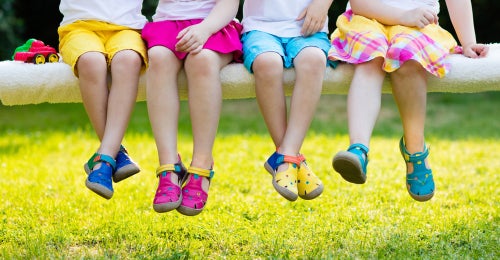
The US footwear industry organisation says children’s shoe prices have reached the highest in over 70 years, which is causing serious issues for those who can least afford it.
It says rising costs in the shoe supply chain are a contributing factor for shoe retail price increase but argues US government import taxes now make up 30% of the price of certain types of children’s shoes at big box retailers where most working-class families shop.
“This is the major reason why kids’ shoe price inflation is well above other basic goods,” it adds.
In a letter to the President, FDRA CEO Matt Priest points to a tweet by chief of staff Ron Klain that endorsed the opinion “Most of the economic problems we’re facing (inflation, supply chains, etc.) are high class problems.”
Priest says: “This idea is totally wrong. Poor and working-class families are paying skyrocketing cost increases on kids’ shoes across the country.”
Priest points out that children’s shoes are hit with one of the highest tariff rates of any product sold in the US.

US Tariffs are shifting - will you react or anticipate?
Don’t let policy changes catch you off guard. Stay proactive with real-time data and expert analysis.
By GlobalDataHe says: “Children’s shoe tariff rates often start at 20% or 37.5% and can reach nearly 70%. In fact, the highest tariff rates are generally placed on lower value footwear, creating a regressive hidden tax for working-class families. In addition, for those few children’s shoes with relatively lower rates, the 301 tariffs led to drastic rate increases. With the added 301 tariffs, the tariff rate doubled for certain children’s casual shoes and slippers, and it more than tripled for certain plastic sandals, wool slippers, and infant crib shoes.”
Priest adds the tariffs affect the cost of each shoe before retailers have to add labour, transit, marketing, and other costs to the final price tag. Worse, he says government policies are “actually hurting the pocketbooks of working families more than those of wealthy families when it comes to kids’ shoes because of how our laws are written and the new trade rules imposed.”
He acknowledges the Biden administration cannot directly reduce supply chain costs but says it can directly help to reduce the “disproportionate retail price spikes” by eliminating 301 tariffs on kids’ shoes.
“That would immediately help every family. Further, we urge you to consider eliminating tariffs on children’s shoes altogether for basic fairness and good economic policy. Help us reduce the sticker shock parents are seeing in stores by ending the burden of tariffs on kids’ shoes today.”
Earlier this month, the American Apparel & Footwear Association (AAFA) shared its concerns on the Biden administration’s plans to continue collecting apparel and footwear goods tariffs.
AAFA president Steve Lamar said: “At a time when industry is struggling with an unprecedented supply chain crisis due to our crumbling infrastructure, economic fallout from a damaging pandemic, and unprecedented freight costs, it is distressing that the administration has chosen to continue to subject US companies to these damaging taxes.”



